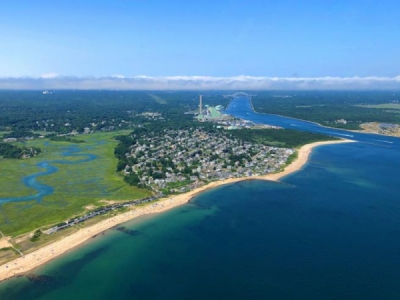
Posted on August 11, 2020
A final draft of the US Army Corps of Engineers study into why Town Neck Beach has lost so much sand is expected to be finished and available to the public by the end of this summer, an Army Corps official said this week.
“Although we have encountered some bumps along the way, we are on track to have a draft report by the end of August,” Michael S. Riccio, project manager for the Army Corps’ New England District, said in a telephone interview this week.
Although Mr. Riccio said he could not yet discuss all the findings in the report, he did confirm that the Army Corps bears much of the responsibility for the erosion at Town Neck Beach.
“We have identified that the canal jetties have caused significant erosion,” Mr. Riccio said. “It’s not entirely caused by the jetties, but they are by and large the primary problem.”
The feasibility report will not address how to stop the erosion, but it will look at the impacts of sand deprivation and how they can be mitigated, he added.
Although Mr. Riccio did not discuss specific remedies in the interview, Town Manager George H. (Bud) Dunham told the selectmen earlier this year that the Army Corps will be recommending that $12.5 million worth of sand be deposited on Town Neck Beach.
That 388,000 cubic yards of sand would be dredged from a site just off Scusset Beach, Mr. Dunham has said. The “borrow” site was approved by the Army Corps late last year.
It remains unclear whether the Army Corps will help maintain the beach’s dune by agreeing to regularly deposit sand after every routine dredging of the Cape Cod Canal.
“We recognize that the problem will continue to exist and [the report] will look at options for the long term,” Mr. Riccio said.
Mr. Dunham has said the town should ask the Massachusetts federal legislative delegation to lobby Washington DC for an ongoing maintenance agreement.
Specifically, the final draft is expected to acknowledge that the jetty—which was built by the Army Corps in the 1940s—caused hundreds of thousands of cubic yards of sand to be diverted from Town Neck Beach.
The $12.5 million—which is the maximum the Army Corps can pay the town for this project—would just about cover the cost of “borrowing,” or dredging, the 388,000 cubic yards of sand from Scusset and delivering it to Town Neck, officials have said.
The Woods Hole Group, the town’s beach consultant, has said the town needs more than 450,000 cubic yards of sand to bring Town Neck Beach back to health.
Mr. Riccio said that after the report is published, the public will be invited to review the document and make comments and suggestions. After the public comment period, the report will be revised and forwarded to the Army Corps’ North Atlantic Division for final approval.
Final approval is expected by the end of the calendar year and then the project will enter the design and implementation phase, Mr. Riccio said.
“It becomes a little more nebulous at this point. It could start next fall but in all likelihood it will be 2022,” Mr. Riccio said. “It has us holding our breath.”
The town had been negotiating and working with the New England District of the Army Corps for years. The North Atlantic Division is the next step up, and the project can get underway only when approval from the larger division is granted.
Natural Resources Director David J. DeConto has said environmental permits are still needed from state and federal authorities before any dredging is done.
The dredging must not disturb shellfish beds, right whales and turtles; and the town must conduct a survey to ensure that the sand is not deposited atop “complex bottom” areas that are a rich source of algae, town officials have said.
“We’re excited to see light at the end of the tunnel on what has been a long process for the town,” Mr. Riccio said.
Source: capenews





